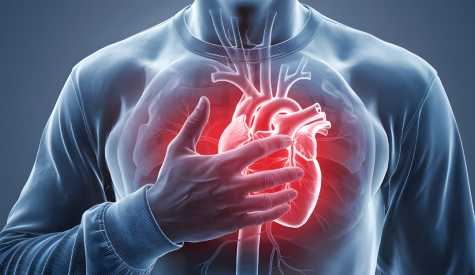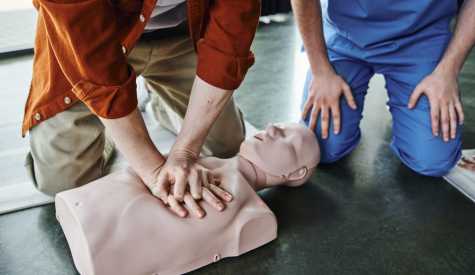Why Learning CPR is More Important Than You Think

February is Heart Month, giving organizations and individuals the opportunity to raise awareness about heart health and the importance of learning lifesaving skills, including how to perform cardiopulmonary resuscitation (CPR) and use an automated external defibrillator (AED). While CPR and AED training might seem like basic skills or simply a workplace requirement, learning CPR is more important than you think.
Each year, hundreds of thousands of adults and children experience cardiac emergencies. The difference between life and death often depends on whether someone nearby is willing and able to respond.
The realities of sudden cardiac arrest
Cardiac arrest is among the leading causes of death in the United States and worldwide. The most dramatic occurrence — sudden cardiac arrest (SCA) — can happen with little to no warning for individuals of all ages.
More than 436,000 people die from cardiac arrests each year in the United States alone. Alarmingly, nearly 91% of out-of-hospital cardiac arrests are fatal.
A person’s chance of survival decreases by 10% for every minute that passes without CPR and defibrillation. This means bystanders are the key to increasing survival rates for sudden cardiac arrest and other cardiac emergencies.

Bystander CPR: The power of immediate action
Effective CPR and early defibrillation with an AED can more than double a victim’s chance of survival. This is why healthcare and emergency care organizations across the world unite to bring awareness about the importance of CPR and AED training. The more trained bystanders, the more lives can be saved.
Bystander CPR helps to restore limited oxygen to the brain and other vital organs by maintaining blood flow through a combination of chest compressions and rescue breaths. But in cases of SCA, CPR alone isn’t enough. An electric shock from an AED is needed to restore the heart’s normal contractions.
Immediate CPR along with early AED use significantly improves the likelihood of long-term survival and recovery.

Everyday heroes making a difference
Stories of otherwise ordinary individuals — often with no medical background — stepping up during emergencies highlight the importance of widespread CPR training. Here are a few examples of recent CPR stories:
- Athletic staff save 16-year-old football player after a tackle causes cardiac arrest.
- High school basketball player saved by opposing team member.
- 11-year-old Girl Scout saves her father after learning CPR.
What do each of these save stories have in common? Bystanders with formal training and CPR certification. CPR and AED training prepared them to recognize the signs and symptoms of cardiac arrest and empowered them to act during a life-threatening situation.
That said, bystanders with no training can and do make a difference. Here’s how:
- Calling 911. Calling for help immediately is the first step in the chain of survival. It ensures emergency responders are on their way and can provide advanced care as quickly as possible.
- Performing hands-only CPR. If you aren’t trained or don’t feel comfortable performing traditional CPR, compression-only CPR can still save a life. Simply push hard and fast on the center of the chest, aiming for about 100-120 compressions per minute. Provide continuous compressions until professional help arrives or another bystander takes over.
- Keeping the scene safe and calm. There is often chaos and confusion during an emergency situation. Your calm demeanor and focused actions can help keep the victim and other bystanders safe. For example, you can direct specific bystanders to call 911 or retrieve an AED. If bystanders are already performing CPR, ask for others who are trained or willing to be next in line to take over as needed.
There are many roles that bystanders can play during an emergency. You just have to be willing to step up and act.
Why you should learn CPR
Learning CPR is not just an important skill. It's a critical component of community health and safety. Here are some of the benefits of CPR training:
- Learn lifesaving skills. Comprehensive CPR, AED, and First Aid training includes adult, child, and infant CPR and AED use. But it also covers a wide variety of medical emergencies and safety topics, from responding to a stroke or heart attack to choking and burns.
- Increase confidence. CPR training enables you to act confidently during a medical emergency, potentially saving the life of a family member, friend, or stranger. It gives you the opportunity to practice real-life scenarios — including chest compressions, rescue breaths, and AED use — while receiving constructive feedback to improve your abilities.
- Improve survival rates. Every minute counts during a cardiac emergency. The longer a person goes without CPR, the lower their chances of survival. Combining high-quality CPR with early defibrillation can significantly increase survival rates and long-term recovery efforts.
- Boost community safety. Widespread CPR knowledge creates a safer environment for everyone, as more individuals are prepared to respond during cardiac emergencies. From schools and workplaces to public places and private residences, the more people with CPR training, the stronger and safer our communities become.
Countless lives are lost each year to cardiac arrest. But we have the power to change that. By learning CPR and AED skills, you can be ready to make a lifesaving difference when every second counts.
This Heart Month, take the step to get trained. You never know when you might join the ranks of the everyday hero.
Take a CPR, AED, and First Aid course with an authorized HSI Instructor.
Become an HSI Instructor and begin teaching lifesaving skills for your organization and within your community.


